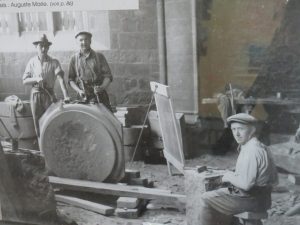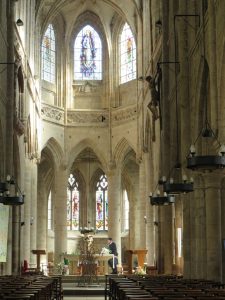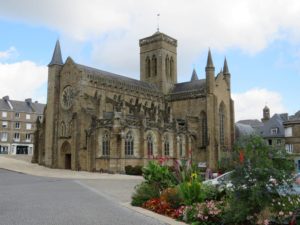As the leaping flames engulfed the steeple we watched in horror as the spire crumpled and fell on the roof of the famous Notre Dame cathedral in Paris, caving in the ancient Gothic structure. I had wandered around for hours inside this beautiful cathedral, listening to the choir practising a Benjamin Britten piece, and soaking in the atmosphere like the other tourists there.
I had looked for signs of stonemason’s marks and sought out the structural elements inside the cavernous space. The beautiful circular window rose high above the worshippers and was admired as were the many artefacts, statues and paintings.
A few days later in 2016 I caught a bus for Caen at Port Maillot, then transferred to another smaller vehicle and travelled on to Vire in Normandy, admiring the landscape that was so ravaged by the second World War. The town is so-called because it is located on the river Vire.
This picturesque town contains another Notre Dame, Church of Our Lady.

Notre Dame Church, Vire Normandy France
Constructed on the site of 12th century Romanesque sanctuary built by Duke of Normandy King Henry I Beaudere it is Gothic in style. Classified as an historical monument in 1862, it is a smaller version of the Paris cathedral. Outside the church, symbols of the different builders’ fellowships are visible under the gargoyles. Inside the church, the incredible work of rebuilding the structure is evident in the permanent exhibition and images.
This Notre Dame Church was also severely damaged. British bombers on 6 June 1944, around 8.00 pm at night, destroyed almost the whole town of Vire. ‘One of the two target marking flare groups was out of alignment and much of the bombing fell across the town of Vire’, killing many of the inhabitants. ‘The Master Bomber in charge of the operation identified the problem and issued corrections to the incoming aircraft’ but the bombing from the first wave of aircraft had destroyed most of the town.
By the painstaking work of stonemasons and architects the church has been restored to its former glory and is once again one of the most beautiful granite monuments in Normandy. Photos inside the church show Guy Fleury (chapeau) and Felix Esnault, with Auguste Marie and other workers, managing huge stone pillars and dressing granite. Some of the photographs clearly show their tools and positions of working and are dated 18 June 1949.
‘Notre Dame monument classe est sous la protection des Monuments Historiques. So restauration est confiée au cabinet de l’archiveste vireos David, supervise par l’archete en chef venu de Paris M Calas. Les travaux débutent en Décembre 1948 et vont durer plus de 10 ans conduits par le chef de travaux Aristide Cudicio de l’Entreprise Degaine de Paris. Moi un tailleur de pierre varois taille une base moulurée des travées nord de la nef par équarrissent préalable.’
Translation: Notre Dame monument class is under the protection of Historical Monuments. So restoration is entrusted to the cabinet of the David vireos archive, supervised by the chief architect from Paris, M Calas. The work begins in December 1948 and will last more than 10 years led by the head of works Aristide Cudicio of the Degaine Company of Paris. … stonemason cut a molded base of the spans north of the nave by squaring previous …

Photograph from explanatory panels inside Notre Dame de Vire showing stonemasons working on the repair of the church.
Les tailleurs de pierre travaillent selon des normes extrêmement rigoureuses, millimétrées portées sur le plan remis par l’architecte. La realisation d’un chipaiteau de piller nocessite 24 jours de travail. Le tailleur de pierre Felix Esnault (debout) termine lo taille de la partie galbée circulaire d’un clapiteau a la massette et pointerolle. Au premier plan Auguste Marie au fond Arsene Guerin.
Translation: The stonemasons work according to extremely rigorous, millimeter-sized standards laid on the plan delivered by the architect. The realization of a chipraiseau to pillage nocessite 24 days of work. The stonemason Felix Esnault (standing) finishes the size of the circular curved part of a clapper to the mallet and chisel. In the foreground Auguste Marie in the background Arsene Guerin.
There are photos of still uncompleted work dated 1957. If it were finished on schedule, ten years after beginning the work, it would be completed around 1958.


In 2016 Notre Dame de Vire (the Church of Our Lady) stands proud as a living testament to the work of restoration stonemasons and architects, see the photographs (right) of the central nave and altar. Photo credit: Dorothy Wickham 2016.
For information on Notre Dame de Paris see the Podcast – Episode 15 – Notre Dame de Paris – by PhD candidate Gary Girod. He explains its fascinating history from the first cathedral on the Paris site, to present day restorations after the fire of 15 April 2019. http://thefrenchhistorypodcast.com/podcasts/FHPEp15.mp3
